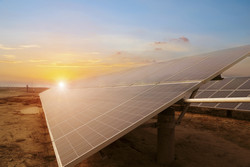Saving solar energy for a rainy day through hydrogen conversion
While solar energy is renewable and abundant enough to meet Europe’s growing energy demand, sunny days are not always guaranteed. Finding a cost-effective means of storing solar energy for a ‘rainy day’ would go some way to solving this problem. This was the challenge addressed by the COCHALPEC project, part-funded through an EU Marie-Curie Intra-European Fellowship (IEF) grant, which officially ended in May 2015. The project’s success could help Member States in their obligations to fulfil the Renewable Energy Directive, which requires the EU to fulfil at least 20 % of its total energy needs with renewables by 2020. The Directive specifies national renewable energy targets for each country, ranging from a low of 10 % in Malta to a high of 49 % in Sweden. The COCHALPEC (Development of electrodes based on copper chalcogenide nanocrystals for photo-electrochemical energy conversion) project’s starting point was to develop – in an efficient and cost-effective manner – solar panels capable of generating an electrical current to split water molecules into oxygen and hydrogen (hydrogen has been shown to be a viable form of solar fuel). While the concept is simple, the cost of water-splitting technologies has – until now – been too expensive to commercialise. In response to this challenge, the COCHALPEC team found a way of making efficient, low-cost solar panels that are capable of directly producing solar hydrogen. The key to this solution was the adoption of so-called 2-D materials – sometimes referred to as single layer materials – which consist of a single layer of atoms. Perhaps the best-known 2-D material is graphene, a single-layer of graphite that, like other potential 2-D materials, offers extraordinary electronic properties. Manufacturing graphene to cover a wide-enough area to harvest usable amounts of solar energy is not cheap. The team therefore developed a new cost-effective manufacturing method using tungsten diselenide. Recent research has suggested that this 2-D material offers conducting properties similar to graphene, and could have potential as an efficient material to convert solar energy directly into hydrogen fuel. The project team next turned to finding a way of cost-effectively manufacturing these tungsten diselenide-based solar panels. This was achieved by mixing tungsten diselenide powder with a liquid solvent, which turned the material into thin 2-D flakes. These flakes were then spread evenly to produce a high-quality thin film, which was then transferred to a newly designed plastic support panel. Final testing successfully demonstrated that this cost-effective method could achieve high solar-to-hydrogen conversion efficiency rates. Most promisingly, the team behind the innovation are confident that the new method can be scaled up to a commercial level. The success of the project underlines the effectiveness of EU Marie-Curie IEF funding, which helps researchers willing to develop their career in Europe outside their home country. In addition to bringing key expertise together to work on specific project – in this case the COCHALPEC project –, the funding also enables European scientists to broaden their horizons and improve their career prospects.
Countries
Switzerland



